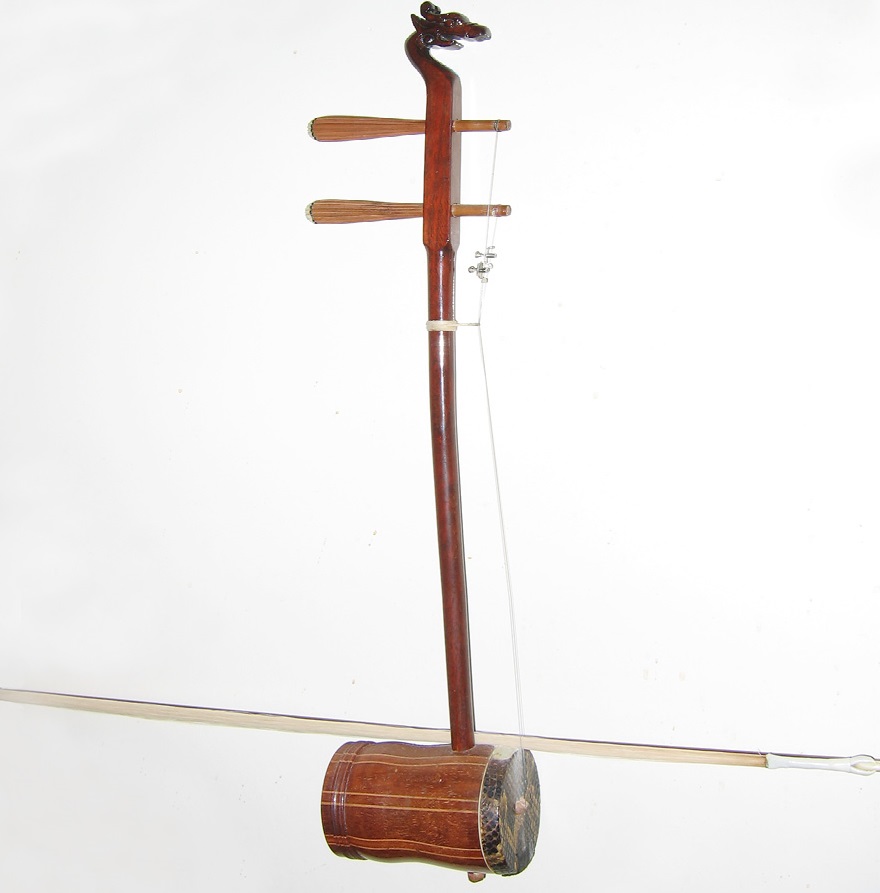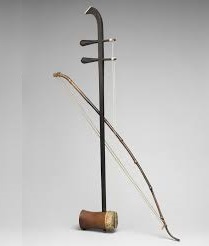Huqin
Bowed Instruments
Asia
Between 0 and 1000 AD
Video
The huqin (胡琴) is a traditional Chinese musical instrument with a history that stretches back over a thousand years, closely intertwined with the cultural and artistic evolution of China. It belongs to the family of bowed string instruments and plays an integral role in both classical and folk Chinese music. Today, the huqin encompasses a variety of instruments, each unique in its characteristics and use. Through its long history, the huqin has left an indelible mark on Chinese music, contributing to the nation’s rich cultural heritage.
History and Origins of the Huqin
The history of the huqin can be traced back to the Tang dynasty (618–907 AD) in China, though its predecessors likely existed even earlier. The huqin is believed to have evolved from instruments that were brought to China along the Silk Road, with influences from Central Asia, Persia, and even the Mongolian steppes. During the Tang dynasty, musical exchanges between China and other civilizations flourished, and the huqin emerged as a result of these interactions. Early versions of the huqin were similar to the Central Asian rabāb, a stringed instrument played with a bow. The huqin was named for the Hu people (an ancient term for Central Asian or foreign tribes), who were associated with these instruments. Over the centuries, the huqin evolved to become a staple of Chinese musical ensembles, particularly in the fields of folk and classical music. During the Ming (1368–1644) and Qing (1644–1912) dynasties, the huqin family began to diversify. Various forms and regional variants emerged, each with its own distinct characteristics. This period also saw the development of the huqin as an instrument of storytelling, often used in Chinese opera and dramatic performances.
Characteristics and Features of the Huqin
The huqin is a bowed string instrument typically characterized by a wooden body, two strings, and a bow made from horsehair. Its shape and structure can vary depending on the type, but several key features remain constant.
Shape and Construction: The body of the huqin is traditionally made from wood, often with a skin (usually python or snake skin) stretched over the resonating chamber. This skin is an important part of the sound production, as it helps to amplify the vibrations of the strings. The neck of the instrument is generally short and straight, and the instrument is played upright.
Strings: The huqin typically has two strings, although some variants have more. These strings are made from either steel or nylon and are tuned to different pitches depending on the type of huqin being played.
Bow: The bow used to play the huqin is distinct in that it is often strung with horsehair, creating a unique sound texture. The bow is used to draw across the strings, producing the instrument’s characteristic haunting, rich tones.
Sound: The huqin’s sound is highly expressive, capable of a range of emotions from sorrowful and melancholic to bright and uplifting. The tone is mellow yet penetrating, and the pitch can be adjusted by pressing the fingers along the fingerboard.
Size and Portability: Depending on the specific type of huqin, the instrument can vary in size. Some versions are designed to be played seated, while others are more portable, allowing for use in traveling performances.
Types of Huqin
The huqin family is diverse, with several different types of instruments used for a variety of purposes in Chinese music. The most common types of huqin include:
- Erhu (二胡): Perhaps the most famous and widely used variant, the erhu is often referred to as the “Chinese violin.” It has a relatively small body and is used in both folk and classical music, as well as in popular and contemporary Chinese music. The erhu is renowned for its expressive quality, especially in solo performances. It has two strings, which are tuned in perfect fifths.
- Jinghu (京胡): The jinghu is a smaller and higher-pitched huqin, often used in Peking opera (Beijing opera). It has a higher, more piercing sound that blends well with the vocal style and instruments of Chinese opera. The jinghu is essential for accentuating the dramatic emotional range of Peking opera performances.
- Gaohu (高胡): A variation of the erhu, the gaohu is typically tuned higher and is primarily used in Cantonese opera. It has a slightly smaller body and produces a brighter, sharper sound. This instrument is key to the distinctive sound of Cantonese classical music.
- Zhonghu (中胡): The zhonghu is similar to the erhu but has a slightly lower pitch and a deeper, warmer sound. It is used in orchestras and ensembles, providing a more rounded tone to balance the higher-pitched instruments.
- Banhu (板胡): The banhu is another huqin family member with a distinct sound. It is often used in northern Chinese folk music and has a sharp, staccato quality. It is typically played with a very fast and energetic bowing technique, making it an exciting addition to traditional ensembles.
- Xiaohu (小胡): The xiaohu is a smaller version of the erhu and produces a higher, sharper pitch. It is used in a variety of regional performances, especially in areas where folk music is central to cultural expression.
Huqin in Chinese Compositions and Music
Throughout its history, the huqin has played an important role in Chinese music, especially in the context of traditional and folk music. In orchestras, it provides the harmonic foundation and enriches the tonal palette of musical compositions.
Classical Music: The erhu, gaohu, and zhonghu are often used in classical Chinese music, particularly in orchestras. Composers such as He Luting and Liu Tieshan have written significant works for the huqin, showcasing its ability to convey deep emotion and tell a story through sound.
Folk Music: In folk music, the huqin is central to ensemble performances. Its plaintive tone is perfect for expressing themes of longing, nostalgia, and the natural world. Many Chinese folk songs use the huqin to provide both melody and accompaniment.
Opera and Drama: The huqin, particularly the jinghu, is essential in Chinese opera. In Peking opera, the huqin adds drama and intensity to the vocal performances, heightening the emotional stakes and complementing the rapid and stylized movements of the actors.
Film Scores and Contemporary Music: In modern times, the huqin has also found a place in film scores and contemporary music. Its evocative sound has been used in numerous films, both within China and internationally, to evoke a sense of Chinese culture and tradition.
The Significance of the Huqin
The huqin holds immense cultural significance in Chinese society. Its distinctive sound resonates with the Chinese people’s connection to their history, traditions, and emotions. Whether in the context of a bustling folk performance, the intricate melodies of Chinese opera, or the graceful tunes of classical Chinese music, the huqin remains an instrument of both artistic and emotional expression.
The instrument is a symbol of China’s rich musical heritage, representing the fusion of ancient traditions with evolving musical forms. The huqin also embodies the philosophy of Chinese music—seeking harmony between the performer, the instrument, and the surrounding world. It stands as a testament to the enduring power of sound, resonating across centuries to evoke the feelings of countless generations.
FAQ
What is the origin of the Huqin?
The Huqin is a traditional Chinese bowed string instrument, believed to have originated during the Tang Dynasty (618–907 AD). It evolved from earlier instruments brought to China by Central Asian merchants along the Silk Road, and has since become an integral part of Chinese music.
What is the significance of the Huqin in Chinese culture?
The Huqin holds cultural significance in Chinese music, especially in traditional folk and operatic genres. It is used in various forms of Chinese theater, such as Peking opera, and is also featured in regional orchestras, symbolizing the depth and diversity of Chinese musical traditions.
What are the features of the Huqin?
The Huqin family includes different variations, such as the Erhu and the Zhonghu. The instruments typically consist of two strings, a hollow wooden body, and a long neck. The sound is produced by bowing the strings with a horsehair bow, and the body is often covered with python or snakeskin to enhance resonance.
 Links
Links
References
Other Instrument
Categories



















